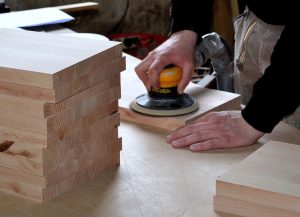Print a Sign-In Sheet | Spanish Version Coming Soon
There are several hazards that may exist when working with wood. The use of various types of woodworking tools and equipment pose hazards as well. It is important to be aware of safety and implement preventative measures to reduce the risk of injury. See the information below for tips to stay safe.
Woodworking Equipment Hazards
- Lacerations
- Amputations
- Burns
- Blindness
- Struck by
- Kickback
- Dust
- Noise
- Electrical
- Moving Parts
- Unguarded Blades
- Vibration
- Fire/Explosion
Dust
- Should not cover more than 5% of work surface and no thicker than 1/32” (thickness of a paperclip).
Basic Woodworking Rules
- Always be aware of potential hazards.
- Follow safe work procedures.
- Maintain proper housekeeping.
Use PPE
- Hearing protection
- Eye and face protection
- Hand protection
- Dust masks and respirators
Clothing should fit snuggly
- Tie hair back
- Remove jewelry
Foot protection
- No open-toed shoes
- Steel-toed shoes
- Anti-skid soles
Basic Woodworking Equipment Requirements
- Be able to cut off power from the operator’s station.
- Power and operating controls readily accessible to the operator.
- Protect foot pedals against accidental activation.
- Guard belts, pulleys, gears, shafts, etc.
- Disconnect switch lockable “off.”
- Ground equipment.
Cutting & Equipment Safety
- Ripping = cutting with the wood grain
- Cross-Cutting = cutting against/across the grain
- Hand-Fed Ripsaws
- Use feed sticks
- Spreaders
- Anti-kickback devices (kickback fingers)
- Saws should be guarded
- Hand-Fed Crosscut Table Saws
- Guard by hood
- Usually adjustable guard
- May adjust the blade height
- Kickback likelihood is much less than with a ripsaw
- All moving parts should be guarded
- Radial Saws
- Must have non-kickback fingers
- Blade from saw cannot extend beyond the table
- When the operator releases the saw, the blade should automatically return to the start position.
- Do not reach over blade
- Vertical & Horizontal Bandsaw
- Blades must be guarded
- Wheels inside the saw must be guarded
- Chopsaw
- The top part of the blade must have a fixed guard
- The bottom part of the blade must have an adjustable guard
- Circular Saw
- Do not use your lap as a sawhorse
- The blade must be guarded
Recordkeeping and Reporting Requirements
- Treatment beyond first aid is OSHA recordable.
- Amputations, loss of eye, fatalities, hospitalizations are OSHA reportable.
Summary
- Always Be Aware
- Guard Moving Parts
- Follow Safe Work Procedures
- Use PPE
- Maintain Proper Housekeeping
KEMI does not assume liability for the content of information contained herein. Safety and health remain your responsibility. This information is to be used for informational purposes only and not intended to be exhaustive or a substitute for proper training, supervision or manufacturers’ instructions/recommendations. KEMI, by publication of this information, does not assume liability for damage or injury arising from reliance upon it. Compliance with this information is not a guarantee or warranty that you will be in conformity with any laws or regulations nor does it ensure the absolute safety of any person, place or object, including, but not limited to, you, your occupation, employees, customers or place of business.

